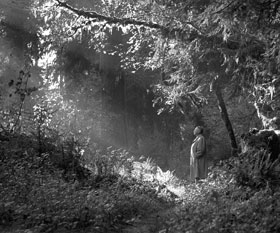  |
| HOME | THIS ISSUE | CALENDAR | GRANTS | BACK ISSUES | < BACK | NEXT > |
Teale collection a rich resource for scholars, students, publicby Karen Singer - February 12, 2007 | ||||||
| Pulitzer Prize-winning author Edwin Way Teale wrote many of his 32 nature books in a tiny cabin overlooking a pond near Trail Wood, his farmhouse in Hampton, Conn. He built the cabin himself, as a near-identical replica of Henry David Thoreau’s at Walden Pond. Teale died in 1980, leaving journals, diaries, field notes, correspondence, photographs, cameras, and copyright on all his books to the UConn Libraries.
Last year, the collection’s photographic materials became easier to access, after an archivist catalogued more than 60,000 items. An inventory is posted on the Thomas J. Dodd Research Center’s web site, and some of the photographs will soon be digitized. The Teale collection, one of the largest at the Dodd Center, is a “rich, diverse, and wonderful resource for researching Teale and the community of writers and naturalists with whom he corresponded throughout his life,” says Melissa Watterworth, curator of literary and natural history collections. UConn students in English, history, art, art history, and environmental history often peruse parts of the collection, as do ornithologists, travel writers, and nature writers. Others request copies. A Duke University Ph.D. candidate, for example, who is researching snake dog trainers, saw a reference in a book by Teale to a trainer the author visited in Florida and asked for copies of some of the materials. This semester a UConn history undergraduate intern is researching Teale’s work at Trail Wood, now a 168-acre sanctuary run by the Connecticut Audubon Society. The Teale collection has spawned University events such as the Edwin Way Teale lecture series on nature and the environment, now in its 10th year, which brings in speakers on environmental issues from a variety of disciplines, and the Creative Writing Program’s annual Edwin Way Teale essay contest. Kentwood Wells, head of the ecology and evolutionary biology department, who read all of Teale’s books as a teenager, saw some of Teale’s notebooks in a 2004 exhibit at the Dodd Center. He says he marvels at the man’s temperament and discipline, adding that Teale’s lyrical prose probably influenced several generations of nature writers and naturalists. Watterworth says work is underway to create a visual display and web exhibit that illustrate Teale’s writing process and his life at Trail Wood through his work, A Naturalist Buys an Old Farm. She says the exhibit will be available on the Dodd Center’s website by late May. Teale’s writing process involved several steps, Watterworth says, such as jotting down notes in his chest pocket notepad, sorting notes into potential stories and chapters, taking photographs to accompany his words, and, after publication, crafting a visual record of his experience in a scrapbook containing letters, receipts, photos, and other memorabilia.
Sydney Plum, an adjunct instructor in English and creative writing, is scrutinizing Teale’s correspondence with environmentalist Rachel Carson. “They were writing at a time when Carson’s Silent Spring was coming out,” says Plum, who will present a paper on her findings at a conference in June. Plum considers Teale’s work a model for her own writing. She first discovered his correspondence with Carson, Marjorie Kinnan Rawlings, Roger Tory Peterson, and others in the 1990s, while researching another nature writer. She also wants to “at least partially retrace the steps” of Wandering Through Winter, the book for which Teale won a Pulitzer. “It’s beautifully written,” Plum says, noting that Teale’s wife, Nellie, accompanied him on that 20,000 mile trip and other journeys across the country for several books following the seasons. “They were amazing people, and a wonderful couple,” Plum adds. “I’d like to do something to pay homage to them … and keep them in people’s minds and hearts.” Nellie played an integral role in Teale’s writing process. “Every day he would write, and every night Nellie would read back to him what he had written,” says Janet Pritchard, an assistant professor of art and art history and landscape photographer. Pritchard “stumbled onto” the Teale collection several years ago, while looking for material on Ann Zwinger, a nature writer who traveled with the Teales and collaborated with the author on his last book, retracing an 1839 canoe trip taken by Thoreau and his brother on the Merrimack River. Pritchard, who has photographed Teale’s writing cabin and home at Trail Wood, says most of the author’s photos were “scientific documents,” but he also took some “very lovely images that were done as visual expressions.” Pritchard often takes her students to look at Teale’s photos at the Dodd Center, so they can see “a variety of ways of working.” Last fall, as part of an interdisciplinary honors course on Thoreau, which Pritchard helped devise, a group of students also examined several journals containing references to Thoreau. “It was really an eye-opening experience for them,” she says. “You can tell people Teale was meticulous and obsessive, but until you see these primary resources you don’t know it.” Contact with original material is “very compelling,” she adds, “and gets students to think it’s possible to conceive of themselves as potential scholars, researchers, or producers of anything.” |
| ADVANCE HOME UCONN HOME |


